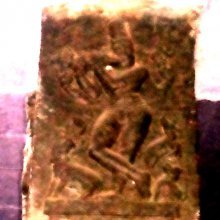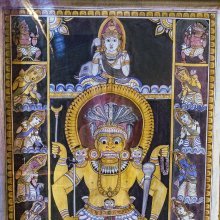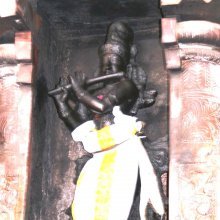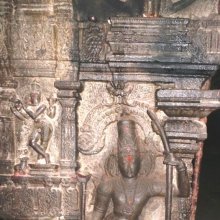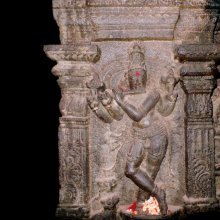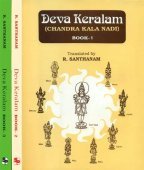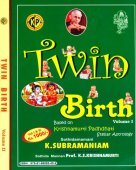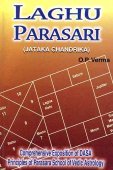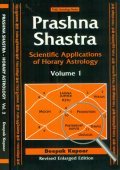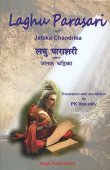Venu, Veṇu, Veṇū: 34 definitions
Introduction:
Venu means something in Buddhism, Pali, Hinduism, Sanskrit, the history of ancient India, Marathi, Jainism, Prakrit, Hindi, biology, Tamil. If you want to know the exact meaning, history, etymology or English translation of this term then check out the descriptions on this page. Add your comment or reference to a book if you want to contribute to this summary article.
Images (photo gallery)
(+1 more images available)
In Hinduism
Purana and Itihasa (epic history)
Source: Google Books: Cultural History from the Vāyu PurānaVeṇu (वेणु): a Musical Instrument.—The Ṛgveda mentions Vāṇa and Das. suggests the Veṇu might have been a later corruption of Vāṇa. But there is no definite opinion on this point. In the Jātakas, however, the Veṇu or flute is found to be a popular wind instrument. The epics also mention Veṇu. The Vāyu-purāṇa associates it with the Kurus already mentioned above.
Source: archive.org: Nilamata Purana: a cultural and literary studyVeṇu (वेणु) refers to a “musical instruments” that existed in ancient Kashmir (Kaśmīra) as mentioned in the Nīlamatapurāṇa.—The Nīlamata says that the land of Kaśmīra was thronged with ever-sportive and joyful people enjoying continuous festivities. Living amidst scenes of sylvan beauty they played, danced and sang to express their joys, to mitigate their pains, to please their gods and to appease their demons.
The Nīlamata refers to Veṇu once only in connection with the celebrations of the Awakening of god Viṣṇu.
Source: Cologne Digital Sanskrit Dictionaries: The Purana IndexVeṇu (वेणु).—Flute;1 in Rāma's abhiṣeka;2 in Pātālam.3
Source: JatLand: List of Mahabharata people and placesVeṇū (वेणू) is a name mentioned in the Mahābhārata (cf. II.48.2) and represents one of the many proper names used for people and places. Note: The Mahābhārata (mentioning Veṇū) is a Sanskrit epic poem consisting of 100,000 ślokas (metrical verses) and is over 2000 years old.

The Purana (पुराण, purāṇas) refers to Sanskrit literature preserving ancient India’s vast cultural history, including historical legends, religious ceremonies, various arts and sciences. The eighteen mahapuranas total over 400,000 shlokas (metrical couplets) and date to at least several centuries BCE.
Shilpashastra (iconography)
Source: Google Books: Elements of Hindu iconographyMuraḷi or Veṇu (वेणु) is a flute made, as its name indicates, from a thin and hollow bamboo. In a piece of bamboo, suitably chosen holes are bored in proper places. By blowing in the hole which is near to the closed end and stopping one or more of the other holes with the fingers as required, music of a very high standard of perfection is often elicited from this simple instrument.
Source: Shodhganga: The significance of the mūla-beras (śilpa)Venu or Murali refers to a type of musical instrument, representing one of the several “attributes” (āyudha) or “accessories” of a detiy commonly seen depicted in Hindu iconography, defined according to texts dealing with śilpa (arts and crafs), known as śilpaśāstras.—Venu or Murali is a flute made, as its name indicates, from a thin and hollow bamboo. In a piece of bamboo, suitably chosen, holes are bored in proper places. By blowing in the hole which is near the closed end and stopping one or more of the other holes with the fingers as required, music of a very high standard of perfection is often elicited from this simple instrument.

Shilpashastra (शिल्पशास्त्र, śilpaśāstra) represents the ancient Indian science (shastra) of creative arts (shilpa) such as sculpture, iconography and painting. Closely related to Vastushastra (architecture), they often share the same literature.
Natyashastra (theatrics and dramaturgy)
Source: Wisdom Library: Nāṭya-śāstraVeṇu (वेणु) refers to one of the thirty-three alaṃkāras (embellishments), according to the Nāṭyaśāstra chapter 29. These alaṃkāras, or, ‘embellishments of song’, depend upon the four types of varṇas, which refers to a specific order of musical notes (svara). They are attached to the songs of seven forms, although not generally used in the dhruvās.
According to the Nāṭyaśāstra, “veṇu is that in which the tempo (laya) is playlike”.

Natyashastra (नाट्यशास्त्र, nāṭyaśāstra) refers to both the ancient Indian tradition (shastra) of performing arts, (natya—theatrics, drama, dance, music), as well as the name of a Sanskrit work dealing with these subjects. It also teaches the rules for composing Dramatic plays (nataka), construction and performance of Theater, and Poetic works (kavya).
Shaivism (Shaiva philosophy)
Source: academia.edu: The Yoga of the MālinīvijayottaratantraVeṇu (वेणु) refers to one of the ten kinds of sounds (śabda) according to the Padārthādarśā of Rāghavabhaṭṭa, the Matsyendrasaṃhitā and the Haṃsa-upaniṣad.

Shaiva (शैव, śaiva) or Shaivism (śaivism) represents a tradition of Hinduism worshiping Shiva as the supreme being. Closely related to Shaktism, Shaiva literature includes a range of scriptures, including Tantras, while the root of this tradition may be traced back to the ancient Vedas.
Pancaratra (worship of Nārāyaṇa)
Source: archive.org: Isvara Samhita Vol 5Veṇu (वेणु) refers to “bamboo” and represents one of the seven forest-products that are fit for oblation according to verse 25.59 of the Īśvarasaṃhitā, dealing with the classification of the places for building the fire-pits (kuṇḍa). Accordingly, “bamboo (veṇu), śyāmāka, nīvāra (wild gram), jartila, gavīdhuka, karkaṭa and kanaka are the seven which grow in the forest. Śāli is important among them. Others are to be taken in its absence, or that of others”.

Pancaratra (पाञ्चरात्र, pāñcarātra) represents a tradition of Hinduism where Narayana is revered and worshipped. Closeley related to Vaishnavism, the Pancaratra literature includes various Agamas and tantras incorporating many Vaishnava philosophies.
Vaishnavism (Vaishava dharma)
Source: Pure Bhakti: Bhajana-rahasya - 2nd EditionVeṇu (वेणु) refers to:—(also called pāvika) one of Śrī Kṛṣṇa’s flutes that is very small, not more than nine inches long, with six holes on its body. (cf. Glossary page from Bhajana-Rahasya).

Vaishnava (वैष्णव, vaiṣṇava) or vaishnavism (vaiṣṇavism) represents a tradition of Hinduism worshipping Vishnu as the supreme Lord. Similar to the Shaktism and Shaivism traditions, Vaishnavism also developed as an individual movement, famous for its exposition of the dashavatara (‘ten avatars of Vishnu’).
Vedanta (school of philosophy)
Source: Shodhganga: Siva Gita A Critical StudyVeṇu (वेणु) or Veṇugītā refers to one of the sixty-four Gītās commonly referred to in Hindu scriptures.—Gītā is the name given to certain sacred writings in verse (often in the form of a dialogue) which are devoted to the exposition of particular religious and theosophical doctrines. Most of these Gītās [i.e., Veṇu-gītā] originate from the Mahābhārata or the various Purāṇas.
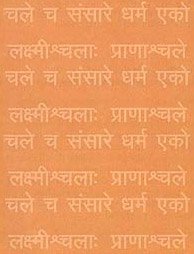
Vedanta (वेदान्त, vedānta) refers to a school of orthodox Hindu philosophy (astika), drawing its subject-matter from the Upanishads. There are a number of sub-schools of Vedanta, however all of them expound on the basic teaching of the ultimate reality (brahman) and liberation (moksha) of the individual soul (atman).
Ayurveda (science of life)
Toxicology (Study and Treatment of poison)
Source: Shodhganga: Kasyapa Samhita—Text on Visha ChikitsaVeṇu (वेणु) (groves) are mentioned in a list of places highly susceptible to snake-bites, as taught in the Kāśyapa Saṃhitā: an ancient Sanskrit text from the Pāñcarātra tradition dealing with both Tantra and Viṣacikitsā—an important topic from Āyurveda which deals with the study of Toxicology (Agadatantra or Sarpavidyā).—The Kāśyapasaṃhitā mentions that snake-bites that happen in certain places [like in places where there are Veṇu groves] are highly inimical to the victim.

Āyurveda (आयुर्वेद, ayurveda) is a branch of Indian science dealing with medicine, herbalism, taxology, anatomy, surgery, alchemy and related topics. Traditional practice of Āyurveda in ancient India dates back to at least the first millenium BC. Literature is commonly written in Sanskrit using various poetic metres.
General definition (in Hinduism)
Source: archive.org: Vedic index of Names and SubjectsVeṇu (वेणु) in the Atharvaveda and later denotes a ‘reed’ of bamboo. It is described in the Taittirīya-saṃhitā as ‘hollow’ (su-ṣira). In the Rigveda it occurs only in a Vālakhilya hymn in a Dānastuti (‘praise of gifts’), where Roth thinks that ‘ flutes of reed ’ are meant, a sense which Veṇu has in the later texts. The Kauṣītaki-brāhmaṇa couples Veṇu with Sasya, stating that they ripen in Vasanta, ‘spring’. Apparently bamboo reeds are meant.
In Buddhism
Theravada (major branch of Buddhism)
Source: Pali Kanon: Pali Proper NamesA river in Ceylon, on the way from Anuradhapura to Dakkhinadesa. It lay between the Tissavapi and Jajjaranadi. VibhA. p. 446.
Theravāda is a major branch of Buddhism having the the Pali canon (tipitaka) as their canonical literature, which includes the vinaya-pitaka (monastic rules), the sutta-pitaka (Buddhist sermons) and the abhidhamma-pitaka (philosophy and psychology).
Mahayana (major branch of Buddhism)
Source: Wisdom Library: Maha Prajnaparamita SastraVeṇu (वेणु) refers to one of the four bodhivṛkṣadevatās “deity of the Bodhi-tree” according to the according to the 2nd century Mahāprajñāpāramitāśāstra (chapter VI). In the Lalitavistara the bodhivṛkṣadevatās are four in number: Veṇu, Valgu, Sumanas and Ojāpati. In the same place, there is a detailed description of the bodhi tree.

Mahayana (महायान, mahāyāna) is a major branch of Buddhism focusing on the path of a Bodhisattva (spiritual aspirants/ enlightened beings). Extant literature is vast and primarely composed in the Sanskrit language. There are many sūtras of which some of the earliest are the various Prajñāpāramitā sūtras.
India history and geography
Source: Shodhganga: Cultural history as g leaned from kathasaritsagaraVenu, Vamsa or Kicaka is the name of a tree mentioned in the Kathasaritsagara by Somadeva (10th century A.D).—Venu refers to the “Bamboo-tree” and its woods in the Vindhya mountains and great and marvellous forests on the Hemakuta peak of the Himalaya mountain are mentioned.
Somadeva mentions many rich forests, gardens, various trees (e.g., Venu), creepers medicinal and flowering plants and fruit-bearing trees in the Kathasaritsagara. Travel through the thick, high, impregnable and extensive Vindhya forest is a typical feature of many travel-stories. Somadeva’s writing more or less reflects the life of the people of Northern India during the 11th century. His Kathasaritsagara (‘ocean of streams of story’), mentioning Venu, is a famous Sanskrit epic story revolving around prince Naravahanadatta and his quest to become the emperor of the vidyadharas (celestial beings).

The history of India traces the identification of countries, villages, towns and other regions of India, as well as mythology, zoology, royal dynasties, rulers, tribes, local festivities and traditions and regional languages. Ancient India enjoyed religious freedom and encourages the path of Dharma, a concept common to Buddhism, Hinduism, and Jainism.
Biology (plants and animals)
Source: Google Books: CRC World Dictionary (Regional names)Venu in India is the name of a plant defined with Mollugo cerviana in various botanical sources. This page contains potential references in Ayurveda, modern medicine, and other folk traditions or local practices It has the synonym Pharnaceum cervianum L. (among others).
Example references for further research on medicinal uses or toxicity (see latin names for full list):
· Journal of the Indian Botanical Society (1954)
· Species Plantarum (1753)
· Taxon (1978)
· Prodromus Systematis Naturalis Regni Vegetabilis (DC.) (1824)
If you are looking for specific details regarding Venu, for example pregnancy safety, chemical composition, side effects, diet and recipes, extract dosage, health benefits, have a look at these references.

This sections includes definitions from the five kingdoms of living things: Animals, Plants, Fungi, Protists and Monera. It will include both the official binomial nomenclature (scientific names usually in Latin) as well as regional spellings and variants.
Languages of India and abroad
Pali-English dictionary
Source: BuddhaSasana: Concise Pali-English Dictionaryveṇu : (m.) bamboo.
Source: Sutta: The Pali Text Society's Pali-English DictionaryVeṇu, (cp. Vedic veṇu. Another P, form is veḷu (q. v.)) bamboo; occurs only in cpds. e.g. —°gumba thicket of bamboo DhA. I, 177; —°tinduka the tree Diospyros J. V, 405 (=timbaru C.); —°daṇḍaka jungle-rope J. III, 204; —°bali a tax to be paid in bamboo (by bamboo workers) DhA. I, 177; °-vana bamboo forest J. V, 38. (Page 647)

Pali is the language of the Tipiṭaka, which is the sacred canon of Theravāda Buddhism and contains much of the Buddha’s speech. Closeley related to Sanskrit, both languages are used interchangeably between religions.
Marathi-English dictionary
Source: DDSA: The Molesworth Marathi and English Dictionaryvēṇu (वेणु).—m S A bamboo. 2 A bamboo flute or pipe.
Source: DDSA: The Aryabhusan school dictionary, Marathi-Englishvēṇu (वेणु).—m Bamboo; a bamboo flute or pipe.
Marathi is an Indo-European language having over 70 million native speakers people in (predominantly) Maharashtra India. Marathi, like many other Indo-Aryan languages, evolved from early forms of Prakrit, which itself is a subset of Sanskrit, one of the most ancient languages of the world.
Sanskrit dictionary
Source: DDSA: The practical Sanskrit-English dictionaryVeṇu (वेणु).—[veṇ-uṇ Uṇādi-sūtra 3.38]
1) A bamboo; मलयेऽपि स्थितो वेणुर्वेणुरेव न चन्दनम् (malaye'pi sthito veṇurveṇureva na candanam) Subhāṣ; R.12.41.
2) A reed, cane; प्राप्तापराधास्ताड्याः स्यू रज्ज्वा वेणुदलेन वा (prāptāparādhāstāḍyāḥ syū rajjvā veṇudalena vā) Manusmṛti 8.299.
3) A flute, pipe; वेणुं क्वणन्तीं क्रीडन्तीम् (veṇuṃ kvaṇantīṃ krīḍantīm) Bhāgavata 1.3.18; नामसमेतं कृतसंकेतं वादयते मृदु वेणुम् (nāmasametaṃ kṛtasaṃketaṃ vādayate mṛdu veṇum) Gītagovinda 5.
4) A banner;. त्रिवेणुं पञ्चबन्धुरम् (triveṇuṃ pañcabandhuram) (ratham) Bhāgavata 4.26.1; cf. त्रिवेणु (triveṇu).
Derivable forms: veṇuḥ (वेणुः).
Source: Cologne Digital Sanskrit Dictionaries: Edgerton Buddhist Hybrid Sanskrit DictionaryVeṇu (वेणु).—name of one of the 4 devatās of the bodhivṛkṣa: Lalitavistara 278.10.
Source: Cologne Digital Sanskrit Dictionaries: Shabda-Sagara Sanskrit-English DictionaryVeṇu (वेणु).—m.
(-ṇuḥ) 1. A bamboo. 2. A flute. 3. A king so named. E. vī substituted for aj to go, aff. nu, or van to sound, ku aff.; or veṇ-uṇ .
Source: Cologne Digital Sanskrit Dictionaries: Benfey Sanskrit-English DictionaryVeṇu (वेणु).—m. 1. A bambu, [Hitopadeśa] iv. [distich] 26; reed, [Pañcatantra] iii. [distich] 57. 2. A flute, a pipe, Brahmav. 2, 50. 3. The name of a king.
Source: Cologne Digital Sanskrit Dictionaries: Cappeller Sanskrit-English DictionaryVeṇu (वेणु).—[masculine] reed, [especially] bamboo-reed (poss. mant†); also = seq. sgl.
--- OR ---
Veṇu (वेणु).—[masculine] reed, [especially] bamboo-reed (poss. mant†); also = seq. sgl.
Source: Cologne Digital Sanskrit Dictionaries: Monier-Williams Sanskrit-English Dictionary1) Veṇu (वेणु):—m. or veṇu ([probably] connected with √1. ve) a bamboo, reed, cane, [Ṛg-veda] etc. etc.
2) a flute, fife, pipe, [Mahābhārata; Kāvya literature] etc.
3) Name of a deity of the Bodhi tree, [Lalita-vistara]
4) of a king of the Yādavas, [Mahābhārata]
5) of a son of Śata-jit, [Viṣṇu-purāṇa]
6) of a mountain, [Mārkaṇḍeya-purāṇa]
7) of a river, [cf. Lexicographers, esp. such as amarasiṃha, halāyudha, hemacandra, etc.]
8) ([plural]) the descendants of Veṇu, [Āśvalāyana-śrauta-sūtra] (veṇor viśāle Name of two Sāmans, [Ārṣeya-brāhmaṇa])
Source: Cologne Digital Sanskrit Dictionaries: Yates Sanskrit-English DictionaryVeṇu (वेणु):—(ṇuḥ) 2. m. A bambu; a flute; a king so named.
Source: DDSA: Paia-sadda-mahannavo; a comprehensive Prakrit Hindi dictionary (S)Veṇu (वेणु) in the Sanskrit language is related to the Prakrit word: Veṇu.
[Sanskrit to German]
Sanskrit, also spelled संस्कृतम् (saṃskṛtam), is an ancient language of India commonly seen as the grandmother of the Indo-European language family (even English!). Closely allied with Prakrit and Pali, Sanskrit is more exhaustive in both grammar and terms and has the most extensive collection of literature in the world, greatly surpassing its sister-languages Greek and Latin.
Hindi dictionary
Source: DDSA: A practical Hindi-English dictionaryVeṇu (वेणु):—(nf) a flute; bamboo; ~[kāra] a flute-maker; ~[vādaka] a flute-player; ~[vādana] flute-playing.
...
Prakrit-English dictionary
Source: DDSA: Paia-sadda-mahannavo; a comprehensive Prakrit Hindi dictionaryVeṇu (वेणु) in the Prakrit language is related to the Sanskrit word: Veṇu.
Prakrit is an ancient language closely associated with both Pali and Sanskrit. Jain literature is often composed in this language or sub-dialects, such as the Agamas and their commentaries which are written in Ardhamagadhi and Maharashtri Prakrit. The earliest extant texts can be dated to as early as the 4th century BCE although core portions might be older.
Kannada-English dictionary
Source: Alar: Kannada-English corpusVēṇu (ವೇಣು):—
1) [noun] a length of the woody, hard, springy stem of various grass of the sub-family Bambusoideae; a bamboo.
2) [noun] a high-pitched wind instrument made of a hollow bamboo stick; a flute.
Kannada is a Dravidian language (as opposed to the Indo-European language family) mainly spoken in the southwestern region of India.
Tamil dictionary
Source: DDSA: University of Madras: Tamil LexiconVēṇu (வேணு) noun < vēṇu.
1. Bamboo; மூங்கில். (பிங்கலகண்டு) [mungil. (pingalagandu)]
2. Reed-pipe; இசைக்குழல். வேணுகானம். [isaikkuzhal. venuganam.]
3. Hollow tube; உட்டுளையுள்ள குழல். (பிங்கலகண்டு) [uttulaiyulla kuzhal. (pingalagandu)]
4. Bow; வில். (பிங்கலகண்டு) வேணுப்புரி தொடை புரளவாங்கி [vil. (pingalagandu) venuppuri thodai puralavangi] (இரகுவமிசம் மீட்சிப். [iraguvamisam midsip.] 65).
5. Sagittarius of the zodiac; தனுராசி. [thanurasi.] (இலக்கண விளக்கம் [ilakkana vilakkam] 882.)
6. Sword; வாள். (சூடாமணிநிகண்டு) [val. (sudamaninigandu)]
Tamil is an ancient language of India from the Dravidian family spoken by roughly 250 million people mainly in southern India and Sri Lanka.
See also (Relevant definitions)
Starts with (+67): Venu-vanam, Venubali, Venubhara, Venubija, Venucakravadya, Venudala, Venudamda, Venudari, Venudarin, Venudarisuta, Venudarita, Venudaritaka, Venudatta, Venudeva, Venudevi, Venudhari, Venudhma, Venugana, Venugita, Venugitasubodhinya yojana.
Ends with: Angaravenu, Bhadravenu, Bhavenu, Dirghavenu, Dvitrivenu, Kvanitavenu, Mahavenu, Makavenu, Mukhavenu, Pindavenu, Ranatvenu, Suvenu, Tananavenu, Trivenu, Upavenu, Vetrakicakavenu.
Full-text (+626): Shukra, Venudhma, Asphujit, Maghabhava, Venunisruti, Daityaguru, Venuvada, Vaiṇa, Vainava, Shodashamshu, Bhargava, Venukiya, Angaravenu, Venuka, Bhriguja, Bhriguvara, Danavapujita, Danavaguru, Shukrasuta, Amararipujya.
Relevant text
Search found 115 books and stories containing Venu, Vēṇu, Veṇu, Veṇū, Vaenu; (plurals include: Venus, Vēṇus, Veṇus, Veṇūs, Vaenus). You can also click to the full overview containing English textual excerpts. Below are direct links for the most relevant articles:
Garga Samhita (English) (by Danavir Goswami)
Verse 4.11.7 < [Chapter 11 - The Story of the Gopīs that were Residents of...]
Verse 2.7.24 < [Chapter 7 - Kidnapping of the Calves and Cowherd Boys]
Verse 1.9.12 < [Chapter 9 - Description of Vasudeva’s Wedding]
Bhakti-rasamrta-sindhu (by Śrīla Rūpa Gosvāmī)
Verse 2.1.366 < [Part 1 - Ecstatic Excitants (vibhāva)]
Verse 2.3.42 < [Part 3 - Involuntary Ecstatic Expressions (sattvika-bhāva)]
Verse 4.9.16 < [Part 9 - Incomplete Expression of Mellows (rasābhāsa)]
Sahitya-kaumudi by Baladeva Vidyabhushana (by Gaurapada Dāsa)
Text 4.93 < [Chapter 4 - First-rate Poetry]
Text 4.50 < [Chapter 4 - First-rate Poetry]
Text 9.25 < [Chapter 9 - Ornaments of Sound]
Brihad Bhagavatamrita (commentary) (by Śrī Śrīmad Bhaktivedānta Nārāyana Gosvāmī Mahārāja)
Verse 2.4.89 < [Chapter 4 - Vaikuṇṭha (the spiritual world)]
Verse 2.2.3 < [Chapter 2 - Jñāna (knowledge)]
Verse 1.1.5 < [Chapter 1 - Bhauma (the earthly plane)]
List of Mahabharata tribes (by Laxman Burdak)
Related products
(+2 more products available)
